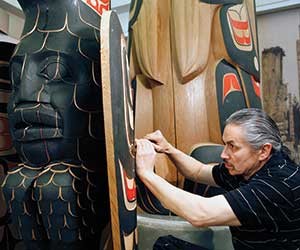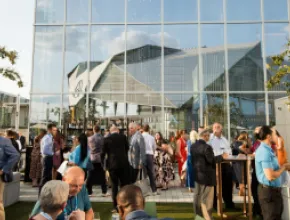While so many components of the Western Canadian experience are already compelling for groups, aboriginal culture seems destined to cement its place in the consciousness of any planner bringing business to this part of the world.
In British Columbia, the Aboriginal Tourism Association of BC leads the pack in facilitating ways for groups to discover Canada through its indigenous culture.
“Everyone is starting to realize how much aboriginal cultural tourism adds to an authentic experience,” explains Paula Amos, marketing manager at Aboriginal Tourism BC. “Actual visitors have been looking for it for a while. They really want to experience our local cuisine, they want to engage with the people.”
Since much of First Nations culture revolves around storytelling, one can imagine a palette of ideas for any itinerary, meal or journey a group undertakes. More and more, business travelers are also asking where they can go check out indigenous art.
“Our art has a story to it,” Amos says. “And it connects to the land, the air, the ocean, and everybody’s pretty conscious about the environment and sustainability, and they seem to like the stories that go along with it. They can relate to it. There’s also been a resurgence in our own communities as well. We want to share it more. With our message, it’s all about inspiring the visitors to come in and engage.”
British Columbia
British Columbia boasts the largest indigenous population anywhere in North America. In an unprecedented scenario, the 2010 Winter Olympic Games occurred within the traditional and shared territories of four different First Nations, so those nations were involved from the very start of the bidding process. Ever since then, aboriginal iconography has proliferated in greater Vancouver at a consistent pace. Convention delegates often receive information on aboriginal activities in their packages.
In Stanley Park, for example, Klahowya Village opens from May to September for large groups. Each year, a different theme presides over the operations. Last year it was Sasquatch, while this year it’s the Spirit Bear. Groups can choose to experience carving demonstrations, walking tours, Metis craft workshops, performances, tastings and more.PageBreak
“We have a 10-minute train ride themed around the Spirit Bear,” Amos says. “We also can bring in entertainment, dance groups and even self-guided tours, so you can learn more about the history of the province and Northwestern art as well.”
All the way across English Bay, at the far western side of the city, the UBC Museum of Anthropology sits near the ocean and welcomes any number of groups year-round. A veritable treasure trove of indigenous artifacts and collectibles, the museum offers numerous configurations, both inside and outside amid Haida Big Houses and towering totem poles.
The options unfold from there. Takaya Tours offers two-hour interpretive paddling trips led by First Nations guides. The Hiwus Feasthouse atop Grouse Mountain features majestic meeting rooms, a cedar longhouse, First Nations cuisine and storytelling. Near the South Granville neighborhood, Salmon ’n’ Bannock Bistro just might be Vancouver’s only authentic aboriginal restaurant, offering space for groups to experience traditional First Nations dishes and artwork.
In Richmond, on the other side of Vancouver’s aboriginal-art-centric airport, one finds the Gulf of Georgia Cannery, where one can book events surrounded by the entire history of the salmon canning industry in British Columbia. Corporate parties and private functions are common.
Two hours north in Whistler, the Squamish Lil’wat Cultural Centre is the only place on Earth showcasing how two different First Nations peoples can operate in the same territory. A theater, banquet hall, aboriginal museum, gallery and cafe all present themselves for groups to revel in native art and exhibits.
Alberta
With more than 40 First Nations peoples calling Alberta home, numerous options exist for any group headed to Calgary, Edmonton or any destination between. Aboriginal culture is never far away for groups that wish to incorporate storytelling, history or other educational experiences.
The Blackfoot people, for example, have been meeting for centuries in the Calgary area, near what’s now Blackfoot Crossing Historical Park. In its entirety, the site features a $25 million, 62,000-square-foot glass complex built by architect Ron Goodfellow. Just about all of the concepts and metaphors incorporated into the design reflect First Nations history and stories. Including the museum, the theater, the art galleries and the shops, the site constitutes the largest indigenous-owned and operated facility in Canada. Many components of the complex, including the theater as well as indoor and outdoor tours, can be incorporated into any group event. Cultural dance and drum performances are also available for conferences. PageBreak
Farther north, the city of Edmonton provides its Festival City Initiative, allowing event planners to integrate Aboriginal entertainers into an event at Fort Edmonton Park, a popular site for group events. Ten different locations and settings throughout the property are available for groups, including banquet rooms, old hotels, a bookstore, a saloon and a church. The park can also handle a complete buyout of up to 5,000 people, which includes access to all the park’s offerings, including the carnival, the performers, the streetcar and the stagecoach. Corporate parties are common, as are historical reenactments.
Manitoba
An environmental research center and conservation facility situated on 600 acres of property in Winnipeg, FortWhyte Alive orchestrates a smattering of recreational programs and corporate team-building activities. Tourism & Corporate Programs Coordinator Lisa Turner explained that one of the signature programs, A Prairie Legacy: The Bison and its People, brings groups directly into the aboriginal experience. The program is also a Canadian Tourism Commission Signature Experience perfect for group travel.
“The idea is to focus on the bison and how it influenced the First Peoples here in Manitoba,” Turner says. “So everyone has the experience of going out to see the bison up close and personal. We see how the First Nations utilized the bison, we get to harvest native berries ... and it also hits on the pioneers and their influence on the prairies, as well as the Metis and the voyageurs.”
Also in Winnipeg, one of the city’s most popular public spaces, The Forks National Historic Site, is steeped in aboriginal history and contains numerous configurations for group events. A small amphitheatre, the Oodena Celebration Circle, is where aboriginal peoples first met 3,000 years ago and now features themed sculptures and signage, while The Wall Through Time also provides historical backdrops for any group event.
Saskatchewan
Thousands of years ago, indigenous nomadic tribes first came to what’s now Wanuskewin Heritage Park in Saskatchewan. Today, one of Canada’s National Historic Sites and officially owned by the city of Saskatoon, the park can boast numerous archaeological finds, some older than the Great Pyramids. For groups wanting to shatter the space-time continuum of the northern plains, there’s an interpretive center, a theater, two galleries, an amphitheater and several prime outdoor endeavors. Common uses of the grounds include corporate meetings in tipis, mock bison hunting and native storytelling applied to modern business strategy.
For a more academic setting in the provincial capital of Regina, the First Nations University of Canada offers numerous indoor and outdoor spaces for events, including a reception area and an atrium. The Veterans Memorial Tipi, for instance is located directly outside the main building.
As a journalist and explorer, Gary Singh infiltrates the Great White North multiple times a year.







